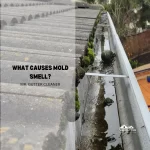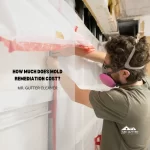Black mold, a common concern in home maintenance, poses significant health risks and property damage if not addressed promptly.
Recognized for its rapid growth in moist environments, this fungus requires immediate attention to prevent its spread, as neglect can lead to extensive damage and health hazards within the household.
Homeowners often detect black mold through visible signs or a distinct musty odor, signaling the need for a thorough inspection to identify and address potential mold infestations before they escalate.
Key areas prone to mold include bathrooms, kitchens, and basements where humidity levels are high.
Effective prevention strategies encompass controlling indoor moisture, ensuring proper ventilation, and regular cleaning.
Early detection and remediation are crucial in mitigating health risks associated with black mold, such as respiratory issues and allergic reactions.
This introduction underscores the importance of vigilance and proactive measures in maintaining a healthy, mold-free home environment, aligning with the central search intent of aiding homeowners in understanding and managing black mold challenges.
What Is Black Mold?
Black mold, scientifically known as Stachybotrys chartarum, thrives in damp, warm environments, often unseen within homes. This toxic mold releases spores that, when inhaled, can lead to serious health complications, underscoring its significance in home maintenance.
Why Is Black Mold a Concern for Homeowners?
Black mold poses significant risks to property and health, necessitating vigilant monitoring and prevention. It not only compromises structural integrity by degrading materials but also triggers health issues ranging from allergies to more severe respiratory conditions. Homeowners must prioritize identifying and addressing mold to maintain a safe living environment.
How Can Black Mold Affect Your Health?
Exposure to black mold spores can lead to a spectrum of health problems. Initially, it may cause symptoms akin to allergic reactions, such as sneezing, itching, and red eyes. Over time, prolonged exposure can exacerbate respiratory conditions, highlighting the urgency of remediation efforts for those residing in affected homes.
Identifying Black Mold in Your Home
Identifying black mold involves recognizing its distinct appearance and preferred growth locations within a home. Awareness of these factors is crucial for early detection and management.
Where Does Black Mold Commonly Appear?
Black mold typically thrives in moist, poorly ventilated areas, including bathrooms, kitchens, basements, and around leaking pipes. Regular inspections of these areas can prevent unchecked mold growth.
What Does Black Mold Look Like?
Black mold, or Stachybotrys chartarum, manifests as dark green to black patches that can appear slimy or damp. Its distinct coloration differentiates it from other mold types, making it recognizable by its almost jet black appearance. This mold thrives on materials with high cellulose content, such as wood, gypsum board, and paper, when they become water-damaged or persistently moist. Identifying black mold by sight is crucial in taking the first step towards remediation.
Visual Characteristics of Black Mold
Black mold is easily identifiable by its dark green to black color and slimy texture. Unlike other mold types, it may also exhibit a powdery appearance when it dries out.
Differences Between Black Mold and Other Mold Types
Compared to other molds, black mold has a more ominous coloring and is often accompanied by a musty odor. Recognizing these differences aids in accurate identification and effective treatment.
Smell: A Key Indicator of Black Mold Presence
A musty, earthy odor is a hallmark sign of black mold presence. This distinct smell can lead homeowners to hidden mold infestations behind walls or under floors.
The Causes of Black Mold in Homes
Understanding the origins of black mold is pivotal for homeowners to effectively prevent its occurrence. Moisture is the primary catalyst for mold growth, necessitating strategies to minimize indoor dampness.
How Does Black Mold Develop?
Black mold flourishes in environments with persistent moisture. Leaks, condensation, and high humidity are common contributors, creating ideal conditions for mold spores to settle and proliferate.
Common Sources of Moisture That Lead to Mold
- Plumbing leaks within walls or under floors.
- Condensation on windows and pipes, especially during colder months.
- Poor ventilation in high-humidity areas like bathrooms and kitchens.
Preventing Mold Growth in Your Home
Mitigating mold growth involves addressing the root causes of moisture accumulation. Regular maintenance and prompt repairs are key strategies.
Effective Home Maintenance Tips
- Ensuring adequate ventilation in moisture-prone areas.
- Using dehumidifiers to reduce indoor humidity levels.
- Regularly inspecting for and repairing leaks in plumbing and roofing.
Testing for Black Mold
Determining the presence of black mold through testing is a critical step in ensuring a safe home environment. This section outlines when and how homeowners should test for black mold, highlighting the distinction between DIY and professional approaches.
When Should You Test Your Home for Black Mold?
Testing for black mold is advisable if you notice signs of mold growth, musty odors, or after water damage. Early detection is key to preventing health risks and structural damage.
DIY Mold Testing Kits vs. Professional Mold Inspection
Deciding between DIY mold testing kits and professional mold inspections involves understanding the advantages and limitations of each method. Homeowners often face the challenge of choosing the most effective approach to accurately detect and assess mold presence in their homes.
DIY Mold Testing Kits
DIY mold testing kits offer a convenient and cost-effective way for homeowners to initially identify mold presence. These kits usually include instructions for collecting surface or air samples, which are then sent to a lab for analysis. The primary benefit is the immediate accessibility and relatively low cost. However, the accuracy of these tests can vary, and they may not provide comprehensive information about the mold type or the extent of an infestation.
Professional Mold Inspection
Professional mold inspections, conducted by certified mold inspectors, provide a thorough assessment of a home’s mold situation. Inspectors use advanced tools like moisture meters and thermal imaging to identify hidden moisture problems that DIY kits might miss. They can also offer detailed information on the type of mold, its health risks, and the necessary remediation steps. Although more expensive, the depth of analysis and accuracy provided by professionals can lead to more effective mold management solutions.
How to Use a DIY Mold Testing Kit
DIY mold testing kits allow for preliminary assessments of mold presence. Follow the kit instructions carefully, typically involving sample collection from air or surfaces, then sending it to a lab for analysis.
Benefits of Professional Mold Inspection
Professional mold inspections offer comprehensive evaluations, including areas not easily accessible to homeowners. Experts can identify mold types and suggest remediation strategies, ensuring a thorough approach to mold management.
Dealing with Black Mold
Effectively addressing black mold infestations is crucial for maintaining a healthy living environment and ensuring the structural integrity of your home. This involves identifying safe removal strategies, deciding when professional help is needed, and implementing long-term prevention measures.
Safe Black Mold Removal Strategies
When tackling black mold, safety is paramount. Homeowners can manage small areas of mold using EPA-approved fungicides and protective gear.
It’s essential to isolate the affected area, use proper ventilation, and ensure personal protection to prevent inhaling spores.
When to Call a Professional for Mold Removal
Professional intervention is recommended for large or inaccessible mold infestations. Experts possess the necessary equipment and expertise to safely remove mold and mitigate its health risks. If mold covers more than 10 square feet or is inside HVAC systems, seeking professional help is crucial.
Long-Term Solutions to Prevent Black Mold Recurrence
Preventing black mold recurrence involves addressing the underlying moisture issues that facilitate mold growth. Improving ventilation, fixing leaks promptly, and maintaining optimal humidity levels are key strategies. Regular inspections and cleaning can also help detect and prevent mold growth early.
Legal and Insurance Considerations
Navigating the legal and insurance landscape is a critical aspect of dealing with black mold in homes. Homeowners must understand their rights and responsibilities, along with how insurance policies cover mold removal, to effectively manage and mitigate the issue.
Understanding Your Rights and Responsibilities
Homeowners have a responsibility to maintain a safe living environment, which includes addressing and mitigating black mold. In some jurisdictions, there are specific legal obligations to remove mold, especially when renting properties to others. It’s essential to be aware of local laws and regulations regarding mold remediation to ensure compliance and protect health.
Does Home Insurance Cover Mold Removal?
Mold removal coverage varies significantly among home insurance policies. Some policies offer mold remediation coverage, but it often comes with limitations and exclusions. Typically, insurance may cover mold damage if it’s a result of a covered peril, such as water damage from a burst pipe. However, mold due to neglected home maintenance or persistent humidity may not be covered. Homeowners should review their insurance policies closely and consult with their provider to understand the extent of their coverage for mold-related issues.
Frequently Asked Questions About Black Mold
Addressing common inquiries about black mold helps homeowners understand its implications and take appropriate actions. This section aims to demystify black mold by answering prevalent questions.
Can Black Mold Grow on Any Surface?
Black mold can grow on various surfaces, especially those that are porous and retain moisture, such as wood, drywall, and carpet. Non-porous surfaces like plastic and metal can also support mold growth if organic material is present.
How Quickly Can Black Mold Spread in Your Home?
The spread of black mold can be rapid, typically taking 24 to 48 hours to germinate and begin growing after exposure to moisture. Within 1 to 2 weeks, mold can become visible and spread if conditions remain conducive.
Can Cleaning Black Mold Make You Sick?
Yes, cleaning black mold without proper safety measures can expose you to harmful spores, potentially leading to respiratory issues, allergic reactions, and other health problems. It’s crucial to wear protective gear or hire professionals for extensive mold issues.


